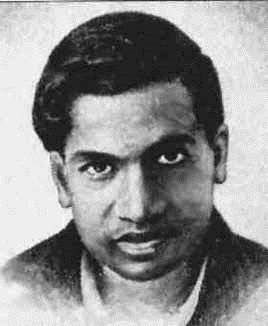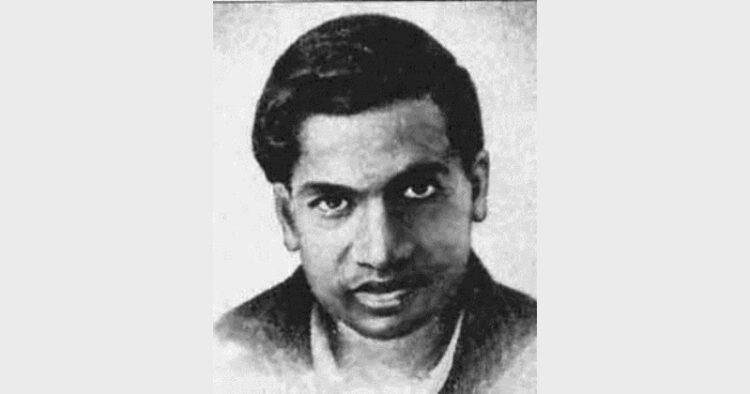Srinivasa Ramanujan Aiyangar, despite no formal training in pure mathematics, still made a substantial contribution to it. His mathematical findings were too novel, unfamiliar and unusual so much that he had to virtually beg for the recognition from the leading mathematicians of his time. Organiser remembers him on his birth anniversary, December 22, which is also celebrated as National Mathematics Day in his memory
-Agrah Pandit

“Infinite series were Ramanujan’s first love.”
One fine day in 1913, Hardy, one of the finest pure mathematicians of his time, received a curious letter. The 10-page letter, sent from Madras started as: ”I beg to introduce myself to you as a clerk…about 23 years of age…I have had no University education…but I am striking out a new path for myself. I have made a special investigation of divergent series in general and the results I get are termed by the local mathematicians as ‘startling’.”
The letter went on to dispute prime number theorem as well as an assertion advanced by Hardy in his paper Orders of Infinity. After having given a pie of the ingenuity behind the letter, it concluded as humbly as it had begun: “I would request you to go through the enclosed papers. Being poor, if you are convinced that there is anything of value I would like to have my theorems published… Requesting to be excused for the trouble I give you.”
This was S. Ramanujan’s third attempt to get recognition by writing to a foreign mathematician of repute, and he seemed to have got it right this time. An awestruck Hardy would later say “I have never met his equal, and I can compare him only with Euler or Jacobi.” Considered as dumb in his childhood, S. Ramanujan would go on becoming arguably the best mathematical mind the world would ever see.
Continuing a Legacy of Obsession with Zero and Infinite
Hundreds of years before the West was still mired in unwieldy Roman numerals, Indians had been using the numerals, number system, number line and other advanced Arithmetic which we use to this day. Mathematics was well-steeped in day to day Sanatana religion, for instance, in the need to know the correct time (muhurta) for Vedic ceremonies, the measurement of Vedic altar, etc.
Of all, zero (nothingness), one or unity (finite) and infinity (everything-ness) occupied the centre stage. The zero was being used from 2nd century BC, if not earlier. Its invention, in response to our finite existence in face of infinite universe, was a remarkable achievement. Infinity too was given its fair share of attention. 10^62 appears in Vedic literature dated 1500 BC. Avatamsaka Sutra approaches infinity in an attempt to comprehend divinity (one large meaningful number is pegged at 10^37218383881977644441306597687849648). “Incalculable” numbers were divined to describe the incalculable names and forms of the divinity.
Surprisingly, infinite and finite and zero for that matter were just different aspects and not wholly unrelated in ancient Indian wisdom as they were in Ramanujan’s theorems. If Lord Vishnu was known as “anantha” (the infinite), He was also known by “shunyah” (zero) and “ekaha” (the one) as given in Sahasranamam (1000 names). When the great 10th century mathematician Bhaskaracharya offered his salutation to God, he referred to Him as Khahara (Kham-zero; hara-divided), thus defining Infinity* in terms of zero. Atman (soul) is finite while paramatman (God) is infinite. Finite can reach infinite by overcoming effects of maya. Infinite thus is not something remotely removed from finite. The path of infinity (moksha) passes through void (nirvana).
Sadly though for the country that believes in rebirth, mathematics had to start all over again in S Ramanujan after a long break of India’s rich mathematical traditions. Fortunately, S Ramanujan would do justice to the traditions of the land obsessed with finite and infinite, nothingness and everything, void and saturation, atma and paramaatma, nirvana and kaivalya.
The letter—like his future work—was replete with infinite series and infinite series ending with a finite solution. The interesting thing is that his infinite series converges to some finite number as if divinity finds expression in individuality as per Indic thought. One such formulae was about continued functions about which Hardy later said “defeated me completely…A single look at them is enough to show that they could only be written down by a mathematician of the highest class.” Hardy was struck by letter’s content—“Theorems such as he had never seen before, nor imagined.”
For a deeply religious, namam-wearing and janeu-bearing, Tamil-speaking and Sanskrit-knowing Ramanujan, the religion and mathematical reality were not distinct. Robert Kanigal comments: “for Ramanujan, numbers and their mathematical relationships fairly threw off clues to how the universe fit together. Each new theorem was one more piece of the Infinite unfathomed. So he wasn’t being silly, or sly, or cute when later he told a friend, ‘An equation for me has no meaning unless it expresses a thought of God.’” He would claim that the family deity Namagiri would write equations on his tongue and would bestow mathematical insights in his dreams.
Further commenting about his theory of reality around Zero and Infinity: Zero, it seemed, represented Absolute Reality. Infinity, or ∞, was the myriad manifestations of that Reality. Their mathematical product, ∞ X 0, was not one number, but all numbers, each of which corresponded to individual acts of creation. Zero and Infinity, like Namagiri, were mathematical object of veneration for him while every rational integer was his “personal friend”.
“My elbow is making me a genius”
Unable to afford pen and paper, S Ramanujan would use a slate for doing rough work before scribbling them on fair sheets. It was easier for him to use his elbow than reaching for a rag to erase when caught up in work. When a friend of him admired him for making up his name in mathematics, his reply was: Look at my blackened and rugged elbow. That will tell you the story. My elbow is making a genius of me. For want of paper, he would re-write from a contrasting ink on the same paper.
During his short lifespan of only 33 years, he complied thousands of unconventional and original theorems which has given rise to a “veritable cottage industry of mathematicians devoted to its study”. Nearly all his hypotheses have been proved correct. Many remain unproved to this day. Clifford Stoll’s comment is apt on this once-in-an-era genius: “What Mozart was to music and Einstein was to physics, Ramanujan was to math…”
*Today, the mathematical standard is to consider ‘division by zero’ as “undefined” and not “infinite”.













Comments